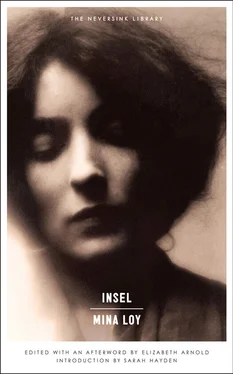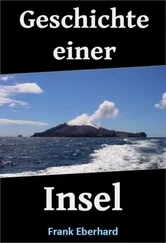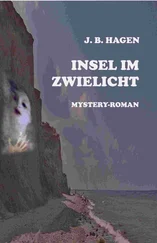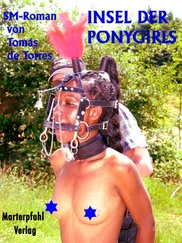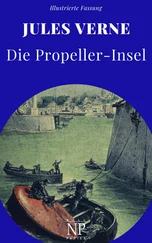We cannot know what caused Loy to resuscitate Insel, but we are certainly prompted to wonder. The narrator of the “Visitation” understands his appearance in New York to signal their “mutual forgiveness.” She suggests two occasions, “his dope-ring duplicity” and her “written account of him,” for which this forgiveness might be forthcoming. A third — that of Jones’s abandonment of Insel — suggests itself for consideration. Inherent in the act of Insel’s Manhattan transfer is the fact of his continued presence in Europe. At the end of the novel, in spite of the “pact” the pair draw up in Chapter Two to get him to America, Insel remains behind to live out the war in the continent from which Mrs. Jones promised to help him escape. As did Oelze. In Becoming Modern: The Life of Mina Loy , Burke writes that “[i]n October 1936, after the failure of their friendship, Oelze made his way to Switzerland,” and nothing in Loy’s biography or writings suggests that she maintained correspondence with Oelze subsequent to that date.
The year 1933—the year of Oelze (and Insel)’s arrival in Paris — had seen the publication of the Deutscher Kunstbericht (German Art Report), signaling the Nazis’ dire intentions for German artists. In the same year, Goebbels established the Reichskulturkammer (Reich Chamber of Culture), and the first Schreckenskammern der Kunst (Horror Chambers of Art) assembled “degenerate art” for exhibition. However, notwithstanding a handful of curt references in Insel to war, the recognition that Oelze’s security is at stake is explicitly articulated only once by Mrs. Jones (this page). By 1936, the precarious position of German artists was abundantly and broadly apparent. In August 1937, The New York Times ran a report headed: “Goering launches the Nazi Art Purge. Orders Broad Clean-Up of All Public Exhibits to Get Rid of ‘Un-German’ Works.” Below it, the subtitle screamed “MODERNISTS ARE TARGET.” A plethora of similarly stark portraits of an artistic community under attack presented America as a haven for German artists at risk of annihilation. If we can suppose that the “Visitation” dates to 1938, it might be worth considering what Loy had learnt in the two years since her solo flight from Paris. Could a dawning awareness of what had been at stake in their exchanges have spurred the author, in Oelze’s absence, to resurrect Insel — the textual avatar of the German artist she had left to his uncertain fate?
While the “written account of him” to which the narrator of the “Visitation” alludes is, we might reasonably presume, Insel itself, the matter of Insel’s “dope-ring duplicity” is rather less straightforward. It has long been believed that Loy attempted to cure Richard Oelze of a debilitating drug addiction. In chapter 16 of the novel, Jones is dismayed to learn from Mlle. Alpha of Insel’s heretofore undivulged history of morphine addiction. Her plaintive coda to this revelation, “[m]oreover, was not Insel’s morphinism a thing of the past?” (this page), remains suspended over the remainder of the novel. The narrator’s suspicion about the endurance of his habit remains, in the novel, remarkably contained — focused almost exclusively in this conversation with Mlle. Alpha. Admitting that she favoured her own idea of him, when confronted with Alpha’s superior knowledge of Insel’s insalubrious past, Jones admits to having “waived this information” (this page).
As the critic David Ayers has remarked, the novel suppresses its own troublingly prosaic suggestion that Insel’s dissipation might, after all, be a product of morphine addiction. Ayers’s diagnosis is lent further credence by the existence, among Loy’s papers, of multiple handwritten fragments of the novel inscribed with the distinctly unambiguous abbreviation, “Morph.” Most of these passages make the transfer into subsequent edits — but they do so divested of their header. Just as Jones denies the possibility that Insel might still be in thrall to his old addiction, Insel ’s readers are denied this narrow interpretation of Insel’s behaviour. Or, given the success of Insel as a novel, perhaps we are liberated from it. Insel’s ability to enrich his personal, elastic, atmosphere with an array of sensory effects suggestive of certain psychopharmacopoeia is construed in the novel as a characteristic of his innate surrealism. In his 1924 “Manifesto of Surrealism,” Breton likens Surrealism itself to a drug, writing: “There is every reason to believe that it acts on the mind very much as drugs do; like drugs, it creates a certain state of need and can push man to frightful revolts.” By alternating rapidly between descriptors for Insel, calling him first “the surrealist man” and then “the drug addict,” the “Visitation” suggestively conflates these terms.
We can only guess as to why Loy chose to minimize this aspect of the narrative. Perhaps, with an eye to a censorious market, the author decided that a novel about a shady surrealist with Black Magic propensities would be more readily publishable than one about a blatant “dope-fiend.” Or, indeed, perhaps her motivation was more aesthetic than pragmatic. Several fragments which never make it in the “first draft” typescript further adumbrate the issue. In one, the narrator asks Aaron whether he could “tell” that Insel “was a morphomane.” His response is blunt: “Naturally — he answered__ he looked queer__ he looked like garbage.” In another example, the narrator addresses a character called Miriam, whose cameo appearances in Insel ’s draft notes were never translated into the novel itself: “Suppose I were sitting outside a Café with a man one would not touch with the tongs & he seemed to have some emanation on which one ascended to heaven — could it be — drugs?” Elsewhere, Miriam laments the “sheer perversity … that a lift to utter realisation of Beauty should leave the Body so ugly.” All of these exchanges, like the “Morph” headers, were cut from later edits.
In this context, the “Visitation” achieves a heightened significance. Potentially reframing the events of the novel as the surreal story of what happened when chance “threw [her] a dope-fiend,” the “Visitation” gives us Jones’s re-evaluation of the events of Insel . Whereas, in the novel, she admits that “drugs meant nothing to” her, the narrator of the “Visitation” regrets her hasty dismissal of opiates as mere “substitute for imagination” (this page). Lamenting her former myopia, she writes: “We hear that a drug in impairing nerve tissue produces a vicious exaltation & our curiosity is no further intrigued.” By explicitly announcing, “Here was my drug addict,” she invites us to re-read the novel, attending more fully to Mrs. Jones’s self-deception, and that of her implied audience. This re-reading delivers a parallel or supplementary, rather than a corrective interpretation of the book. For there is so much more going on in Insel than could be attributed to even the most surrealistically potent narcotics.
The power of the “Visitation” ’s last line pivots on “radium.” That vibratory noun compels us to compare Loy’s “fluctuant” conceptualizations of atomic energy with the equally uneven course of her fascination with Insel. Asked, in a Little Review questionnaire of 1929, “What do you look forward to?” Loy answered: “The release of atomic energy.” Throughout her writing life — from the poem “Gertrude Stein” of 1924 to the post — World War II prose of “Tuning in on the Atom Bomb”—Loy returned again and again to the concept of nuclear force. Her attitudes to atomic energy were heavily imprinted by the catastrophic inception, in that period, of the nuclear age. In its last lines, the “Visitation” elaborates on the significance of the “radio-activity” (this page) which Jones associates with Insel throughout the novel.
Читать дальше
